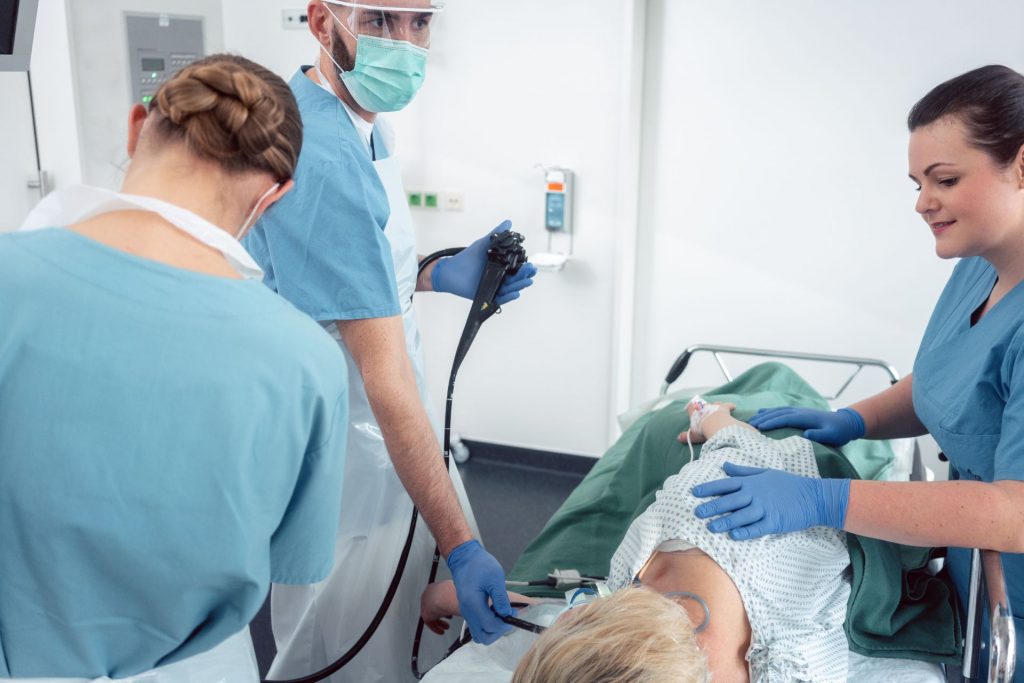
Endoscopy procedure
The procedure will depend to some extent on the reason for the endoscopy.
There are three main reasons for carrying out an endoscopy:
- Investigation: If an individual is experiencing vomiting, abdominal pain, breathing disorders, stomach ulcers, difficulty swallowing, or gastrointestinal bleeding, for example, an endoscope can be used to search for a cause.
- Confirmation of a diagnosis: An endoscopy can carry out a biopsy to confirm a diagnosis of cancer or other diseases.
- Treatment: An endoscope can treat an illness directly; for instance, endoscopy can be used to cauterize (seal using heat) a bleeding vessel or remove a polyp.
Sometimes, an endoscopy will be combined with another procedure such as an ultrasound scan. It can be used to place the ultrasound probe close to organs that can be difficult to image, such as the pancreas.
Modern endoscopes sometimes come with sensitive lights that use narrow-band imaging. This type of imaging uses specific blue and green wavelengths that allow the doctor to spot precancerous conditions more easily.
An endoscopy typically happens while the person is conscious, although sometimes the person will receive local anesthetic (commonly an anesthetic spray to the back of the throat). Often, the person is sedated.
For endoscopy procedures involving entry through the mouth, a mouth guard will protect the teeth and lips as the tube is inserted.
Endoscope use in surgery
Endoscopy has advanced in recent years, enabling some forms of surgery using a modified endoscope. This makes the surgery less invasive.
Procedures such as the removal of the gallbladder, sealing and tying the fallopian tubes, and the removal of small tumors from the digestive system or lungs are now commonplace.
A laparoscope is a modified endoscope used for keyhole surgery (also referred to as laparoscopic surgery).
Laparoscopic surgery requires only a small incision and can be used for appendectomies (removal of the appendix), hysterectomies (removal of the uterus), and prostatectomies (removal of prostate tissue).
Using this technique, people lose less blood during and after surgery and can recover much faster compared with standard surgical procedures.
An endoscopy is a relatively safe procedure. However, there are certain risks involved. Risks depend on the area that is being examined.
Risks of endoscopy may include:
- over-sedation, although sedation is not always necessary
- feeling bloated for a short time after the procedure
- mild cramping
- a numb throat for a few hours due to the use of local anesthetic
- infection of the area of investigation, which most commonly occurs when additional procedures are carried out at the same time (the infections are normally minor and treatable with a course of antibiotics)
- persistent pain in the area of the endoscopy
- perforation or tear of the lining of the stomach or esophagus, a rare but serious complication
- internal bleeding, usually minor and sometimes treatable by endoscopic cauterization
- complications related to preexisting conditions
Any of the following symptoms should be reported to a doctor:
- dark-colored stool
- shortness of breath
- severe and persistent abdominal pain
- chest pain
- vomiting blood
Recovery will depend on the type of procedure. For an upper endoscopy, which lets a doctor examine the upper gastrointestinal tract, the person will undergo observation after the procedure. This usually lasts around 1 hour while any sedative medication wears off.
The person should not usually work or drive for the rest of the day because of the sedative effect of the medication used to prevent the pain. Any cognitive effects trusted Sources should be reported to a doctor prior to leaving the procedure area or after.
There may be some soreness. With this type of endoscopy, there may be bloating and a sore throat. However, these usually resolve quickly.
